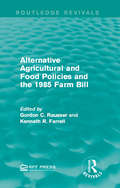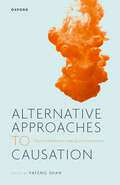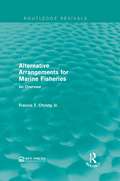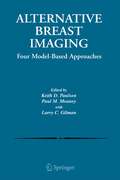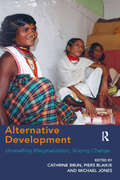- Table View
- List View
Altered Sensations: Rudolph Koenig’s Acoustical Workshop in Nineteenth-Century Paris (Archimedes #24)
by David PantalonyRudolph Koenig was one of the more prolific and colourful instrument makers in the renowned nineteenth-century precision instrument trade of Paris. Beginning his career as a violin maker, in 1858 the young Prussian immigrant shifted his talents towards the growing field of acoustics. Altered Sensations is a portrait of his vibrant atelier, a place of construction, commerce and experiment. For over forty years it was also a popular meeting place for scientists, artisans, musicians and teachers. Using archival and collection research from across North American and Europe, David Pantalony has traced the material and social influences of this space on the development of modern acoustics. In particular, he has detailed the manner in which Koenig modified, extended, spread and challenged Hermann von Helmholtz's Sensations of Tone. A large part of the research on Koenig comes from the actual products of his workshop which survive in museums and collections around the world. The second section of Altered Sensations provides a Catalogue Raisonné of Koenig’s entire line of instruments, including their history, details from specific examples, locations, and references in the literature. This catalogue will serve as a practical guide for curators and researchers as well as a comprehensive overview of nineteenth-century acoustical practice.
Altering Nature: Volume II: Religion, Biotechnology, and Public Policy (Philosophy and Medicine #98)
by Gerald P. McKenny B. A. Lustig B. A. BrodyB. Andrew Lustig, Baruch A. Brody, and Gerald P. McKenny In this second volume of the “Altering Nature” project, we situate specific religious and policy discussions of four broad areas of biotechnology within the context of our interdisciplinary research on concepts of nature and the natural in the first volume (Altering Nature, Concepts of Nature and the Natural in Biotechnology Debates). In the first volume, we invited five groups of scholars to explore the diverse conc- tions of nature and the natural that shape moral judgments about human alterations of nature, as especially exemplified by recent developments in biotechnology. A careful reading of such developments reveals that assessments of them—whether positive or negative—are often informed by different conceptual interpretations of nature and the natural, with differing implications for judgments about the app- priateness of particular alterations of nature. These varying interpretations of nature and the natural often result from the distinctive perspectives that characterize va- ous scholarly disciplines. Therefore, in an effort to explore the variety of meanings that attend discussions of the concepts of nature and the natural, the contributors to the first volume of Altering Nature addressed those concepts from five different disciplinary vantages. A first group of scholars analyzed a range of religious and spiritual perspectives on concepts of nature and the natural. Their research highlighted the thematic, h- torical, and methodological touchstones in those traditions that shape their persp- tives on nature.
Altering Nature: Volume I: Concepts of ‘Nature’ and ‘The Natural’ in Biotechnology Debates (Philosophy and Medicine #97)
by Gerald P. McKenny B. A. Lustig B. A. BrodyB. Andrew Lustig, Baruch A. Brody, and Gerald P. McKenny Nearly every week the general public is treated to an announcement of another actual or potential “breakthrough” in biotechnology. Headlines trumpet advances in assisted reproduction, current or prospective experiments in cloning, and devel- ments in regenerative medicine, stem cell technologies, and tissue engineering. Scientific and popular accounts explore the perils and the possibilities of enhancing human capacities by computer-based, biomolecular, or mechanical means through advances in artificial intelligence, genetics, and nanotechnology. Reports abound concerning ever more sophisticated genetic techniques being introduced into ag- culture and animal husbandry, as well as efforts to enhance and protect biodiversity. Given the pace of such developments, many insightful commentators have proclaimed the 21st century as the “biotechnology century. ” Despite a significant literature on the morality of these particular advances in biotechnology, deeper ethical analysis has often been lacking. Our preliminary review of that literature suggested that current discussions of normative issues in biotechnology have suffered from two major deficiencies. First, the discussions have been too often piecemeal in character, limited to after-the-fact analyses of particular issues that provoked the debate, and unconnected to larger concepts and themes. Second, a crucial missing element of those discussions has been the failure to reflect explicitly on the diverse disciplinary conceptions of nature and the natural that shape moral judgments about the legitimacy of specific forms of research and their applications.
Altern: Alter und Altern individuell, kollektiv und die Folgen (Schriften der Mathematisch-naturwissenschaftlichen Klasse #27)
by Heinz Häfner Thomas W. Holstein Anthony D. HoWir haben immer mehr Alte, immer weniger Kinder. Dank wissenschaftlicher Fortschritte verlängert sich die Lebenserwartung ständig. Erkenntnisse aus der Naturwissenschaft in der post-genomischen Ära deuten darauf, dass diese Entwicklung trotz der Zunahme altersassoziierter Krankheiten und Behinderungen noch nicht am Ende angekommen ist. Droht diese Flut von Alten, Rentnern und „Konsumenten des Lebens“ zum Verlust des Zusammenhalts der Gesellschaft zu führen? Nach der Bestandsaufnahme der jüngsten Errungenschaften der Forschung hat das interaktive Symposium sich mit den Chancen und Gefahren der „gewonnenen Jahre“ auseinandergesetzt. Die Referentinnen und Referenten sind herausragende Vertreter der Biologie und Medizin. Meinungsbildner der Geisteswissenschaften und Persönlichkeiten aus der Politik kamen ebenfalls zu Wort.
Altern: Zelluläre und molekulare Grundlagen, körperliche Veränderungen und Erkrankungen, Therapieansätze
by Ludger Rensing Volkhard RippeDas für ein breites Publikum geschriebene Werk zeigt die kausalen Verbindungen zwischen den messbaren Alterserscheinungen und den zugrundeliegenden Veränderungen in Genen, Zellen und in deren Kommunikationssystemen auf. Molekularbiologische Ansätze gewinnen in Medizin und Pharmakologie immer mehr an Bedeutung (Molekulare Medizin, targeted therapies, genombasierte personalisierte Medizin), und Kenntnisse über kausale Mechanismen der Alterung werden die Vorsorge und Therapie zahlreicher Alterskrankheiten deutlich verbessern können. Die Autoren erläutern diese Zusammenhänge an elf menschlichen Funktionssystemen: Haut, Knochenskelett, Muskulatur, Kreislauf und Lunge, Immunsystem, Verdauungssystem, Ausscheidungssystem, Sexualität und Fortpflanzung, Hormonsystem, zentrales Nervensystem und Sinnesorgane. Jedes Kapitel beginnt mit einer kurzen Übersicht über die normalen Funktionen des Systems; dann werden die altersabhängigen Veränderungen und Erkrankungen mit den zugrundeliegenden molekularen Mechanismen dargestellt. Abschließend gehen die Autoren auf einige medizinische Aspekte von Alterserkrankungen und wichtige therapeutische Ansätze ein. Am Anfang des Buches steht ein einführendes Kapitel über die grundlegenden (evolutions)biologischen Fragen zu Alterungsvorgängen, gefolgt von einer Übersicht über den gegenwärtigen Stand der Altersforschung und die wichtigsten Alterstheorien, darunter die Theorie der Schadensakkumulation und die Theorie der Verkürzung der Chromosomenenden (Telomere). Im letzten Kapitel des Werkes geht es schließlich um die Frage, wodurch die Korrelation zwischen Alter und dem Auftreten der meisten Krebstypen zustande kommt und welche äußeren und inneren Faktoren dabei mitwirken.
Alternaria Diseases of Crucifers: Biology, Ecology and Disease Management
by Gobind Singh Saharan Naresh Mehta Prabhu Dayal MeenaThis book deals with the various aspects viz., the disease, geographical distribution, symptoms on different hosts, host range, yield losses, and disease assessment method, while detailed description on pathogen include taxonomic position, phylogeny, variability, sporulation, perpetuation, and spore germination, host-parasite interactions in the form of seed infection, disease cycle, process of infection, and pathogenesis, epidemiology, forecasting, fine structures, biochemical changes, and phytotoxins, host defence mechanism, techniques to study host-parasite relationships, and management practices including cultural, chemical, biological control practices, and deployment of host resistance. The last section deals with gaps in our understanding, and knowledge about management of these diseases, techniques for the diagnosis of disease and offer suggestions for future research priorities. Each aspect has been vividly illustrated with photographs, histograms, figures, tables, electron micrographs for stimulating, effective and easy reading and understanding. We are sure that this comprehensive encyclopaedic treatise on "Alternaria diseases of crucifers” will be of immense use to the researchers, teachers, students and all others who are interested in the diagnosis and management of Alternaria diseases of crucifers world over. Four species of Alternaria are wide spread and most devastating on cruciferous oil yielding crops, vegetables, forage crops, ornamental plants, and numerous weeds all over the world. The damage to the plants is in the form of infections on seed in the soil during sowing, on seedlings during emergence and growth, on stem, leaves, inflorescence, pods and finally to the seed causing yield losses in seed quantity and quality.
Alternate Light Source Imaging: Forensic Photography Techniques
by Norman Marin Jeffrey BuszkaAlternate Light Source Imaging provides a brief guide to digital imaging using reflected infrared and ultraviolet radiation for crime scene photographers. Clear and concise instruction illustrates how to accomplish good photographs in a variety of forensic situations. It demonstrates how tunable wavelength light sources and digital imaging techniques can be used to successfully locate and document physical evidence at the crime scene, in the morgue, or in the laboratory. The scientific principles that make this type of photography possible are described, followed by the basic steps that can be utilized to capture high quality evidentiary photographs.
Alternate Light Source Imaging: Forensic Photography Techniques
by Norman Marin Jeffrey BuszkaAlternate Light Source Imaging provides a brief guide to digital imaging using reflected infrared and ultraviolet radiation for crime scene photographers. Clear and concise instruction illustrates how to accomplish good photographs in a variety of forensic situations. It demonstrates how tunable wavelength light sources and digital imaging techniques can be used to successfully locate and document physical evidence at the crime scene, in the morgue, or in the laboratory. The scientific principles that make this type of photography possible are described, followed by the basic steps that can be utilized to capture high quality evidentiary photographs.
Alternating current sine wave (large print)
by RnibThis image shows the difference between alternating current and direct current in the form of waves. The image is a graph where the vertical axis represents the current's polarisation, while the horizontal axis represents time. The top section of the graph shows how direct current has a constant current polarisation over time. The bottom section shows how the currents polarisation for alternating current fluctuates over time, and forms a sine wave.
Alternative Agricultural and Food Policies and the 1985 Farm Bill (Routledge Revivals)
by Gordon C. Rausser Kenneth R. FarrellIn 1985, the U.S. Congress confronted the difficult and complex task of developing a 5-year omnibus legislation allowing for lower commodity prices. But, policies predicated on the concept of agriculture as a unique sector of the economy became less and less appropriate to the highly interdependent, open agricultural economy throughout the 1980s. First published in 1985, this collection of 16 papers and related discussions contained in these proceedings is an important contribution toward understanding the issues, options, and dilemmas in U.S. agricultural policy. This is an ideal title for students interested in environmental studies, agriculture, and national policy.
Alternative Agricultural and Food Policies and the 1985 Farm Bill (Routledge Revivals)
by Gordon C. Rausser Kenneth R. FarrellIn 1985, the U.S. Congress confronted the difficult and complex task of developing a 5-year omnibus legislation allowing for lower commodity prices. But, policies predicated on the concept of agriculture as a unique sector of the economy became less and less appropriate to the highly interdependent, open agricultural economy throughout the 1980s. First published in 1985, this collection of 16 papers and related discussions contained in these proceedings is an important contribution toward understanding the issues, options, and dilemmas in U.S. agricultural policy. This is an ideal title for students interested in environmental studies, agriculture, and national policy.
Alternative Antriebe für Automobile: Hybridsysteme, Brennstoffzellen, Alternative Energieträger
by Cornel StanDie vierte Auflage dieses Werkes präsentiert, auf Basis der neusten Forschungs- und Entwicklungsergebnisse sowie von Prototyp- und Serienausführungen, zukunftsweisende Antriebssysteme für Automobile – von Elektroantrieben mit Batterien oder Brennstoffzellen bis hin zu Plug In Hybridsystemen. Die Antriebskonzepte werden entsprechend der umgesetzten Prozesse und Funktionen analysiert und nach einheitlichen Kriterien wie spezifische Leistung, Drehmomentverlauf, spezifischer Kraftstoffverbrauch und Abgasemission bewertet. Die alternativen Kraftstoffe werden in Bezug auf Verfügbarkeit, Produktion, technischer Komplexität der Speicherung an Bord, Kosten, Sicherheit und Infrastruktur verglichen. Das Buch enthält Zusammenfassungen zu den bisher entstandenen Elektromobilen, Hybriden und Plug In Fahrzeugen. Die zukünftigen Antriebe für Automobile werden von Vielfalt geprägt sein – von den Lösungen für kompakte Stadtwagen, Mittelklassewagen, Fahrzeugen mit Reichweitenverlängerung und SUV’s bis hin zu preiswerten Mehrzweckwagen.
Alternative Approaches to Causation: Beyond Difference-making and Mechanism
by Yafeng ShanCausation is one of the most controversial topics in philosophy. There is a wide range of philosophical accounts of causation, for example, the regularity account, the probabilistic account, the counterfactual account, the interventionist account, which can be all classified as 'difference-making' accounts; and the mechanistic account. Many argue that only one of these accounts is correct as there is only one type of causal relation (causal monism), while others maintain that there are multiple types of causation (causal pluralism). In addition, there are eliminativists argue that science has no need of causation at all, while primitivists maintain that causation is unanalysable. Recently, the difference-making and mechanistic approaches have dominated recent philosophical discussion of causation. Other approaches and positions have been insufficiently discussed and assessed, especially in the context of philosophy of science. This volume explores and examines alternative approaches to causation. It revisits causal primitivism and causal eliminativism in the context of recent literature. It further explores the pluralistic approach, the fictionalist approach, the inferentialist approach, and the informational approach. It also examines the application of the dispositional approach, the epistemic approach, and the powerful particulars approach to the natural and social sciences. Overall, the volume is complementary to the recent discussion on the difference-making and mechanistic approaches and sheds new light on the metaphysical, epistemological, conceptual and methodological issues on causation. As such, it provides foundations for further research and teaching of this hotly debated topic.
Alternative Approaches to Causation: Beyond Difference-making and Mechanism
by Yafeng ShanCausation is one of the most controversial topics in philosophy. There is a wide range of philosophical accounts of causation, for example, the regularity account, the probabilistic account, the counterfactual account, the interventionist account, which can be all classified as 'difference-making' accounts; and the mechanistic account. Many argue that only one of these accounts is correct as there is only one type of causal relation (causal monism), while others maintain that there are multiple types of causation (causal pluralism). In addition, there are eliminativists argue that science has no need of causation at all, while primitivists maintain that causation is unanalysable. Recently, the difference-making and mechanistic approaches have dominated recent philosophical discussion of causation. Other approaches and positions have been insufficiently discussed and assessed, especially in the context of philosophy of science. This volume explores and examines alternative approaches to causation. It revisits causal primitivism and causal eliminativism in the context of recent literature. It further explores the pluralistic approach, the fictionalist approach, the inferentialist approach, and the informational approach. It also examines the application of the dispositional approach, the epistemic approach, and the powerful particulars approach to the natural and social sciences. Overall, the volume is complementary to the recent discussion on the difference-making and mechanistic approaches and sheds new light on the metaphysical, epistemological, conceptual and methodological issues on causation. As such, it provides foundations for further research and teaching of this hotly debated topic.
Alternative Arrangements for Marine Fisheries: An Overview (Routledge Revivals)
by Francis T. Christy, Jr.The maintenance of the freedom of fishing in the face of the changing circumstances that were occurring at the time of this title’s original publication in 1973 had produced several damaging consequences. It had led to considerable waste, in both biological and economic terms, and had been the source of increasing conflict. This waste can only be prevented by the adoption of management measures and by the removal of the condition of free and open access. This book explores various techniques for this, and will be of interest to students of environmental management.
Alternative Arrangements for Marine Fisheries: An Overview (Routledge Revivals)
by Francis T. Christy, Jr.The maintenance of the freedom of fishing in the face of the changing circumstances that were occurring at the time of this title’s original publication in 1973 had produced several damaging consequences. It had led to considerable waste, in both biological and economic terms, and had been the source of increasing conflict. This waste can only be prevented by the adoption of management measures and by the removal of the condition of free and open access. This book explores various techniques for this, and will be of interest to students of environmental management.
Alternative Breast Imaging: Four Model-Based Approaches (The Springer International Series in Engineering and Computer Science #778)
by Keith D. Paulsen Paul M. Meaney Larry GilmanMedical imaging has been transformed over the past 30 years by the advent of computerized tomography (CT), magnetic resonance imaging (MRI), and various advances in x-ray and ultrasonic techniques. An enabling force behind this progress has been the (so far) exponentially increasing power of computers, which has made it practical to explore fundamentally new approaches. In particular, what our group terms "model-based" modalities-which produce tissue property images from data using nonlinear, iterative numerical modeling techniques-have become increasingly feasible. Alternative Breast Imaging: Four Model-Based Approaches explores our research on four such modalities, particularly with regard to imaging of the breast: (1) MR elastography (MRE), (2) electrical impedance spectroscopy (EIS), (3) microwave imaging spectroscopy (MIS), and (4) near infrared spectroscopic imaging (NIS). Chapter 1 introduces the present state of breast imaging and discusses how our alternative modalities can contribute to the field. Chapter 2 looks at the computational common ground shared by all four modalities. Chapters 2 through 10 are devoted to the four modalities, with each modality being discussed first in a theory chapter and then in an implementation-and-results chapter. The eleventh and final chapter discusses statistical methods for image analysis in the context of these four alternative imaging modalities. Imaging for the detection of breast cancer is a particularly interesting and relevant application of the four imaging modalities discussed in this book. Breast cancer is an extremely common health problem for women; the National Cancer Institute estimates that one in eight US women will develop breast cancer at least once in her lifetime. Yet the efficacy of the standard (and notoriously uncomfortable) early-detection test, the x-ray mammogram, has been disputed of late, especially for younger women. Conditions are thus ripe for the development of affordable techniques that replace or complement mammography. The breast is both anatomically accessible and small enough that the computing power required to model it, is affordable.
Alternative Development: Unravelling Marginalization, Voicing Change
by Cathrine Brun Piers BlaikieThis book brings together a collection of essays that discuss alternative development and its relevance for local/global processes of marginalization and change in the Global South. Alternative development questions who the producers of development knowledges and practices are, and aims at decentring development and geographical knowledge from the Anglo-American centre and the Global North. It involves resistance to dominant political-economic processes in order to further the possibilities for non-exploitative and just forms of development. By discussing how to unravel marginalization and voice change through alternative methods, actors and concepts, the book provides useful guidance on understanding the relationship between theory and practice. The main strength of the book is that it calls for a central role for alternative development in the current development discourse, most notably related to justice, rights, globalization, forced migration, conflict and climate change. The book provides new ways of engaging with alternative development thinking and making development alternatives relevant.
Alternative Development: Unravelling Marginalization, Voicing Change
by Cathrine Brun Piers BlaikieThis book brings together a collection of essays that discuss alternative development and its relevance for local/global processes of marginalization and change in the Global South. Alternative development questions who the producers of development knowledges and practices are, and aims at decentring development and geographical knowledge from the Anglo-American centre and the Global North. It involves resistance to dominant political-economic processes in order to further the possibilities for non-exploitative and just forms of development. By discussing how to unravel marginalization and voice change through alternative methods, actors and concepts, the book provides useful guidance on understanding the relationship between theory and practice. The main strength of the book is that it calls for a central role for alternative development in the current development discourse, most notably related to justice, rights, globalization, forced migration, conflict and climate change. The book provides new ways of engaging with alternative development thinking and making development alternatives relevant.
Alternative Ecological Risk Assessment: An Innovative Approach to Understanding Ecological Assessments for Contaminated Sites
by Lawrence V. TannenbaumIn Alternative Ecological Risk Assessment the author, Lawrence V. Tannenbaum, provides a critical review of current practices in the ecological risk assessment field and proposes alternatives that are supported by established science and keen observation. It is hoped that this approach will pave the way to a greater understanding of what appropriate and useful ecological assessment for contaminated sites should entail. He demonstrates that in most cases current practices do not provide for an assessment of ecological risk, and moreover, that endeavoring to assess ecological risk is actually an unnecessary undertaking at conventional hazardous waste sites. (He states, for example, that the concept of scale is often ignored by practitioners, questions why animals like deer are routinely assessed at 5-acre sites, and challenges the ecotoxicology data currently used.) The book is aimed at students and professionals in the fields of environmental science, ecology, ecotoxicology, and health risk assessment.
Alternative Ecological Risk Assessment: An Innovative Approach to Understanding Ecological Assessments for Contaminated Sites
by Lawrence V. TannenbaumIn Alternative Ecological Risk Assessment the author, Lawrence V. Tannenbaum, provides a critical review of current practices in the ecological risk assessment field and proposes alternatives that are supported by established science and keen observation. It is hoped that this approach will pave the way to a greater understanding of what appropriate and useful ecological assessment for contaminated sites should entail. He demonstrates that in most cases current practices do not provide for an assessment of ecological risk, and moreover, that endeavoring to assess ecological risk is actually an unnecessary undertaking at conventional hazardous waste sites. (He states, for example, that the concept of scale is often ignored by practitioners, questions why animals like deer are routinely assessed at 5-acre sites, and challenges the ecotoxicology data currently used.) The book is aimed at students and professionals in the fields of environmental science, ecology, ecotoxicology, and health risk assessment.
Alternative Education for the 21st Century: Philosophies, Approaches, Visions
by P. WoodsThis is a unique collection of leading examples of education grounded in alternative philosophies and cultures – from initiatives to create more democratic schools, through Quaker, Buddhist, Islamic, Montessori and Steiner/Waldorf schools, to Maori and First Nations education in Canada and Palestinian Jewish schools in Israel.
Alternative Energies: Updates on Progress (Advanced Structured Materials #34)
by Germán FerreiraThis book presents nine chapters based on fundamental and applied research of alternative energies. At the present time, the challenge is that technology has to come up with solutions that can provide environmentally friendly energy supply options that are able to cover the current world energy demand. Experts around the world are working on these issues for providing new solutions that will break the existing technological barriers. This book aims to address key pillars in the alternative energy field, such as: biomass energy, hydrogen energy, solar energy, wind energy, hydroelectric power, geothermal energy and their environmental implications, with the most updated progress for each pillar. It also includes the life cycle assessment (LCA) and thermoeconomic analysis (TA) as tools for evaluating and optimising environmental and cost subjects. Chapters are organized into fundamental research, applied research and future trends; and written for engineers, academic researches and scientists.
Alternative Energietechnik
by Jochem UngerDer Hauptinhalt des vorliegenden Buches ist neben technisch wichtigen Auslegungs- und Sicherheitskriterien für konventionelle, nukleare und regenerative Energiesysteme das Erkennen, das Beurteilen und Berücksichtigen der vom menschlichen Wirtschaften verursachten Rückwirkungen, das prinzipielle Problem der Nicht-Quantifizierbarkeit umweltrelevanter Entscheidungskriterien und Auswege aus diesem Dilemma. Zusätzlich werden aber auch gesellschaftspolitische Aspekte ins Spiel gebracht, die selbstorganisierend vom darwinistischen Wirtschaften hin zu einem humanen volkswirtschaftlichen Prozess führen, der das ökologische Minimalprinzip gerade vollständig ausschöpft. Die anschauliche Darstellung der Sachverhalte mit Hilfe einfachster mathematischer Modelle setzt nur elementare Kenntnisse der Mathematik und der jeweils relevanten Fachdisziplinen voraus. Zur Vertiefung und Übung sind zahlreiche Aufgaben mit Angabe des Lösungswegs beigefügt. Das Buch wurde für die neue Auflage vollständig überarbeitet. Insbesondere wurden die technischen Aspekte dieses in rasanter Bewegung befindlichen Gebietes auf den neuesten Stand gebracht.









